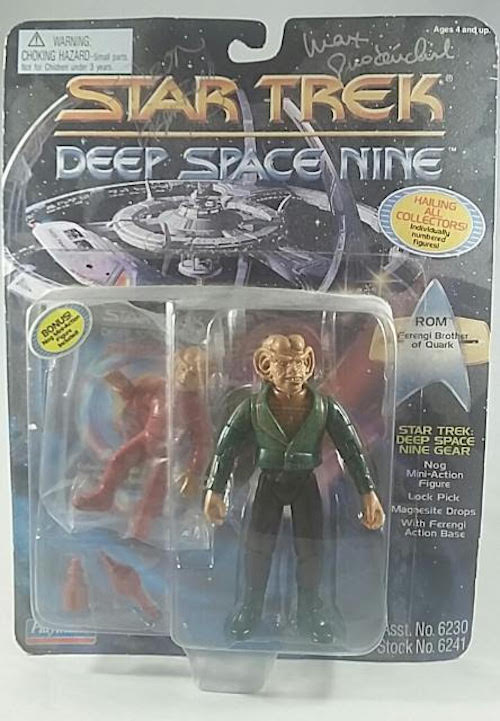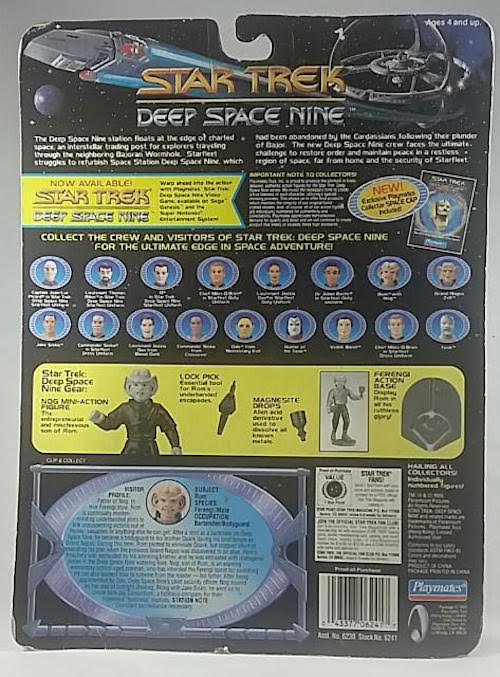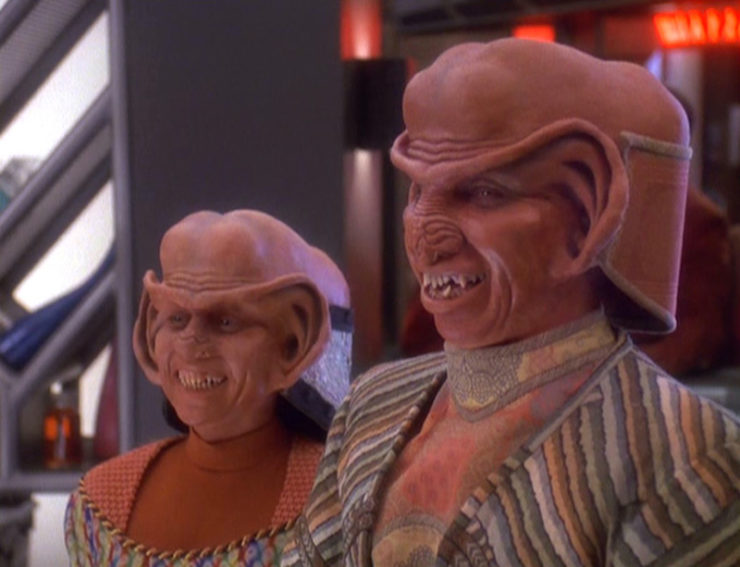The day after Aron Eisenberg died, I found myself looking at his action figure. Well, his character’s action figure, to be precise.
My Nog is still trapped in his bubble, a solid, immovable plastic body contained in a clear baggie suspended next to Rom and above a small, red lock pick and bottle of Magnesite drops. Behind him is a Space Cap, basically a Pog, that only bears the face of Nog’s father. Behind that, is a Ferengi action base, which is something of a misnomer because the “action bases” were often just little plastic insignia with a peg into which the feet of the figures plugged, presumably so that they could display with more stability than their wobbly limbs could promise. In my experience, once on an action base, very little action occurred.
This is a Rom action figure. The front of the card prominently features Rom’s name. The Clip-and-Collect card on the back is all Rom, though the first line of the “Visitor Profile” reads “Father of Nog.” Even the yearbook-style headshot in the “Collect the Crew…” section only shows Rom’s lobes and goofy grin. Nog is listed under “Star Trek: Deep Space Nine Gear.” His black-and-white photo appears next to the aforementioned tiny tools. He’s advertised as a “Mini-Action Figure,” though, like the Action Base, there isn’t much you can really do with him except maybe, maybe make him hold the lock pick for a moment. Rom’s collector’s number, stamped on the bottom of his boot to up the toy’s value for (usually adult) action figure junkies, is 027063. Nog’s is nothing. He doesn’t have one. As far as this action figure set is concerned, it’s Rom’s world. Nog only lives in it.

There were only two times Playmates, the manufacturer of many 1990s-era Star Trek toys, included another major character as an accessory to a single action figure. Nog was one, and Alexander, packaged with Worf in his Western get-up from the episode “A Fistful of Datas,” was the other. There are many similarities between these “accessory figures.” Both came out in 1995. Alexander’s sculpt sort of resembles Nog’s. Both have a right hand raised and a left hand lowered. Both wear a monochromatic, earth-toned outfit. They’re both just a little over two inches tall. Both are the sons in a father-and-son set where only the father is recognized as the product’s main draw. As I look at my Nog figure, another similarity occurs to me: both actors are now dead.
In the case of Alexander, it’s a little different. Many actors played Alexander over the years, and the one who played him in “A Fistful of Datas,” Brian Bonsall, is still alive. However, the first actor to play Alexander, in the episode “Reunion,” Jon Paul Steuer, committed suicide on January 1, 2018. Now, with the loss of Aron Eisenberg, it is hard for me to not view these action figures in a tragic light.
When we are young, especially young sons, it is hard not to be packaged with our fathers. For some of us, this is validating. We long to be our fathers. We crave their independence, their adulthood, and their superheroic auras. But, for others, this is the last thing we want. Our fathers can be abusive, distant, and unaccepting. They can represent everything we know we are not. And yet, there we are. Right next to them. Society has sealed us in our bags alongside our fathers, fitted into matching grooves, and the clear plastic bubbles are hot glued over us both. The packages advertise our fathers, but, sure, we all know that means the sons, too. If the father happens to be a third-rate waiter on a far-flung space station, the son is a mini-version of that. If the father totes two six-shooters to combat a 24th Century Hall of Mirrors gone haywire for the millionth time, then the son gets to wield a smaller and cuter gun of his own. We’re molded in their image, and relegated to the status of “gear.”
The narrative arcs of both Alexander and Nog break this mold, however. Alexander, through his growth over two shows and several actors, forces Worf to confront the reality that his son will not display the same aggressive, warrior masculinity for which he strives. Eisenberg’s Nog goes in almost the opposite direction, from a docile and sometimes-troublemaking kid to a Starfleet soldier grappling with PTSD. Both, though, follow these paths in opposition to their fathers. In the Star Trek: Deep Space Nine Season 3 episode “Heart of Stone,” Commander Sisko asks Nog why he wants to join Starfleet, to which the young Ferengi replies, “I don’t want to end up like my father.” While Nog and Rom are close, Nog sees that his dad neglects his true talents in order to follow his traditional Ferengi programming: work in business, acquire wealth, then die. To extend the toy metaphor, Nog sees in Rom an accessory who never became his own action figure, and fears he will suffer the same fate. Indeed, on the shelves of toy stores and comic shops, Nog’s fate was already sealed.

But not really. In “Heart of Stone,” Eisenberg acts this moment with such determination that Avery Brooks’ Sisko can’t help but crumble. The commander agrees to recommend Nog to Starfleet, and, as we will see over the course of the coming seasons, Nog breaks out of his packaging and gains his own articulation in every sense of the word. In fact, Nog’s transformation is so great that it inspires Rom to embrace his own true calling, thereby flipping the dynamic Playmates established in their action figure set, with Rom now the add-on item to his son’s autonomous, active character.
On a personal level, I need this to be true. I need to know that, even though some may only ever acknowledge me as the product of my packaging, I am more. I usually present pretty masculine, but, ever since a couple of years ago, I am an out Non-Binary person who uses they/them pronouns. I love ambiguity and questions. I think the world is a fundamentally uncertain place where we’re all just, essentially, doing the best we can with what we have. In other words: I am the farthest thing from my father, a scientist prone to expounding on the value of binaries (he does not know I’m, well, Non-) and the foundation of truth atop which we all stand. As a child, I helped him organize bottles of various chemicals in his lab, and, as I did, people would ask if I was going to be like him someday. I have no idea what I told them. I know that, for a period of time, I wanted to say yes. I privileged his precise and absolute worldview because it gave me comfort in a life rocked by the fears of a puberty that intersected with 9/11, a day that eroded many people’s understanding of the known and the possible. As my lived experience and lack of scientific ability moved me farther and farther from the profile printed on the back of my father’s imaginary action figure card, I started carving out my own toy box.
And I’m still not done. It’s hard, when you’re an accessory, building the box that few think you deserve. Others will know this better than me. It feels like, to summon a clichéd metaphor, being a fish who needs to make new water, except no one will tell you what water is. You just have to hope that whatever you’ve made, by virtue of it not being old water, is somehow better. The first few steps run on a belief that, if you perform convincingly enough, materializes into its own reality.
We never got the independent Nog action figure, but we did get the independent Nog. I like to think that, if his toy were to be made today, it would feature the character standing alone in a Starfleet uniform. He’d have 27 points of articulation, but his size wouldn’t be artificially scaled up. Being of smaller stature is not something in need of correction. He might have a cane, and maybe a tux he could be changed into. He’d be capable of expressing every emotion, from elation to grief to mischievousness. The clear plastic bubble enclosing him would be filled with my hope that all of us, myself included, have the ability to rewrite and rebuild our packaging, to stand on our own and with our chosen friends and family and continue to change and evolve. The back of the card would simply read, “No one is an accessory, but we all have the freedom to be extra.”
And there would be a Pog.
Jonathan Alexandratos (they/them) is a Non-Binary playwright and essayist living in New York City. Their book, Articulating the Action Figure: Essays on the Toys and Their Messages, is an edited collection of academic essays on how action figures function as literary texts. Every syllable of Jonathan’s art aims to uplift and empower Queer communities like their own.










